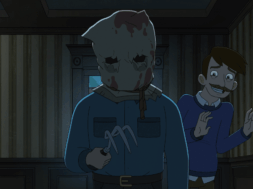“It was one shitty night, don’t let it ruin the rest of your life.”
This line, uttered by Skye in Natalia Leite’s film M.F.A., encapsulates the prevalent attitude toward sexual assault and rape; it is bad, yes, but you can just get over it. Sexual assault on college campuses is a harrowing reality that most administrations have no idea how to address. Perpetrators are rarely reprimanded, while survivors are chastised, shamed, and interrogated to prove they aren’t lying. Sexual assault is treated as a grey area where certain things count, but others don’t, especially if the survivor was drinking. But why is it so hard to believe those brave enough to come forward about their experiences? Leite and writer Leah McKendrick try to grapple with that question in M.F.A.
In my previous column, I wrote about Coralie Fargeat’s Revenge and how it is a fantastical portrayal of violence, a narrative where a woman gets sweet, bloody revenge on those who saw her body as an object to be manipulated and consumed. This month, my focus is on a film that while about enacting justice, is more grounded in the current issues of sexual assault on college campuses, and the range of emotions that survivors experience after trauma. M.F.A is about PTSD, vengeance, and downright rage at how our justice system seems to actively work against those of us who have experienced sexual assault. It also works to complicate the typical rape-revenge plot by complicating Noelle’s quest for revenge and addressing the very real consequences of taking matters into your own hands.
Noelle (Francesca Eastwood) is the film’s feminine avenger, a doe-eyed grad student who keeps to herself and is trying to more deeply access her creativity. But in the process of that discovery, she is raped by Luke, a man in her program. However, Leite and McKendrick do not have him simply violently attack and rape her. Rather they portray the more common narrative of a woman being taken advantage of by a man she already has feelings for. She is interested in him and is attracted to him, so she goes to a party at his house to impress him. She is shown dressing up in a pretty dress and getting the kind of giddy excited you get when you’re about to go hang out with the person you like. She gushes with her friend and she is shown primping in the bathroom before going into his room; there is no denying her interest. But interest does not explicitly connote sex. In fact, she explicitly states her boundaries and revokes any kind of consent. She tries to stop him, pushes him away, and says, “no,” multiple times. Yet, he pushes past those boundaries, taking what he thinks he deserves. She went with him into her room, after all.
The framing of the sexual assault focuses on Noelle and her pain, rather than the spectacle of the event itself. Unlike in Revenge where Jen’s rape is only briefly shown, the camera stays in the room during Noelle’s trauma. It is painful and difficult to watch, but in focusing the camera on Noelle’s face, Leite avoids exploitation; this is not about voyeurism but about empathy. At first, you hear Luke attempting dirty talk, but quickly, his voice fades and it is replaced with buzzing, which conveys Noelle’s own dissociation from the event. This is not a pleasurable moment, but one that she wishes to completely forget and remove herself from. Leite conveys that through making sure the camera never leaves Noelle’s face. This is not about spectacle, but about the pain of experiencing this type of trauma.
But M.F.A. doesn’t stop there in its more realistic portrayal of sexual assault. Noelle is shown suffering from PTSD as she experienced flashes of the trauma while doing everyday tasks, whether it is working on her latest painting or sitting in class. She begins picking at her fingers, breathing heavily, and fidgeting as she is reminded of her rape. They are almost involuntary responses as her mind and body enter fight-or-flight mode, a feeling with which I am unfortunately familiar. Perhaps the most harrowing and accurate look at her PTSD is when she tries to get intimate with someone after her assault. After you’ve been sexually violated, even consensual sex can be triggering. Sexual touch is conflated with violence, which often removes any pleasure that should come from consensual sex. The hands of your partner feel dirty and your skin crawls at their every touch. Pleasure can suddenly turn horrifying, which Noelle experiences as her partner places a hand on her vagina. As if she received an electric shock, she scrambles away from him, quickly associating his touch with the violation of her body and her trust. She cannot simply bounce back from her rape, but unfortunately must realize the lasting effects of such violence.
Where the reality fades away is when Noelle places a hot pink wig on her head and slinks into frat houses to avenge those who have been wronged by entitled men. Her desire for violence is born from the accidental death of her own rapist who falls from a balcony as she confronts him about what he did to her. He laughs in her face and tries to place the blame on her shoulders. Yet he meets a violent end at his own hand. His quick death reflects how Noelle approaches the subsequent murders. Unlike the deaths seen in The Last House on the Left, I Spit on Your Grave, and even in Revenge, this is not about torture or elaborately gory deaths. Instead, Noelle makes their deaths comparatively quick, from drugging to blunt force head trauma. She lures these men to her using what they all want: sexuality. She weaponizes the pieces of clothing used against victims—short skirts, fishnet stockings, tight shirts—and uses them as tools of vengeance; she reclaims what the campus has declared as slutty to punish those who take advantage of such antiquated viewpoints.
But this is not just about Noelle’s experience with sexual assault. Leite and McKendrick create a story about Noelle learning about just how many women are affected by sexual assault. A graphic video makes the rounds of frat bros raping a woman and chanting their fraternity’s name as if rape is a game to be won. Of course, this video is thought to be fake and the blame is placed squarely on the survivor’s shoulders. She explains to Noelle that she was put on trial and questioned relentlessly about her sexual history while her rapists got off with no punishment; in fact, they are still throwing parties like nothing ever happened. But perhaps the most harrowing representation of rape’s prevalence is McKendrick’s character Skye, who changed her name and moved to avoid confrontation with her rapist.
Her storyline is a tragic one as she is shown self-harming and eventually committing suicide. Skye wants nothing more than to forget her trauma and make it just go away, which she had almost achieved. However, Noelle does not respect that as a friend and instead believes that revenge is the best way to help Skye. She wants to punish the man who raped her, foolishly assuming that everyone’s experience with rape is the same and therefore we must all want the same thing. But instead, Noelle retraumatizes Skye. The tragedy of Skye complicates the typical rape-revenge narrative; this is not just about gory violence, but about actively questioning what justice actually means. Skye’s narrative also showcases how rape is not a universal experience; every survivor has their own story and journey that cannot be addressed with blanket statements or acts of vigilante justice. Noelle assumes that Skye shares her emotional reaction to rape and acts accordingly. However, through tragedy, Noelle realizes that revenge isn’t what every survivor wants; sometimes the best coping mechanism is forgetting.
There is a frustrating narrative through M.F.A. that can be read as trauma inspiring art, and that those who have been traumatized create better art. After all, Noelle finally finds her creative streak after she begins enacting her revenge. Her paintings are better received by her professor and classmates, and they seem to possess a more raw and poignant energy. However, a secondary reading can show that something positive can come out of such trauma. While survivors often only dream of revenge against their rapists, artistic outlets can provide another kind of catharsis. It does not lead to justice or punishment, but provides a way to release the mess of feelings that follow trauma. Not only is Noelle seeking justice, but she is achieving another form of release through paints and a blank canvas; through her art, she is able to put images to the roiling emotions inside of her.
In an interview with Rue Morgue, McKendrick said, “Violence against women such as sexual assault is not new. Just because rape is a hot topic now does not mean it is a recent development.” Sexual assault and rape is not a new thing in horror film, but M.F.A. illustrates how horror can reflect societal fears and issues while also providing a source of catharsis. But within that catharsis is a discussion of consequences, as well as the inherently flawed justice system. M.F.A. is purposefully infuriating and illustrates the rage that rape survivors feel coursing through their veins as their rapists run free without any emotional scars. It is a rape-revenge film that carefully examines the slippery slope of revenge within the very real situation of campus assault. Noelle is arrested for her crimes which leaves the audience contemplating what it truly means to enact justice; yes, Noelle committed crimes and faces the consequences but what about the rapists? Why is Noelle so quickly caught and judged while scores of men roam free on campus?
There is no easy answer but the women of M.F.A. don’t want an easy answer; they want to make the audience uncomfortable when confronted with the reality of what’s happening to women on college campuses and around the world. Leite and McKendrick create a powerful and complex narrative dedicated to the experiences of survivors, never once catering or surrendering to the male gaze.













